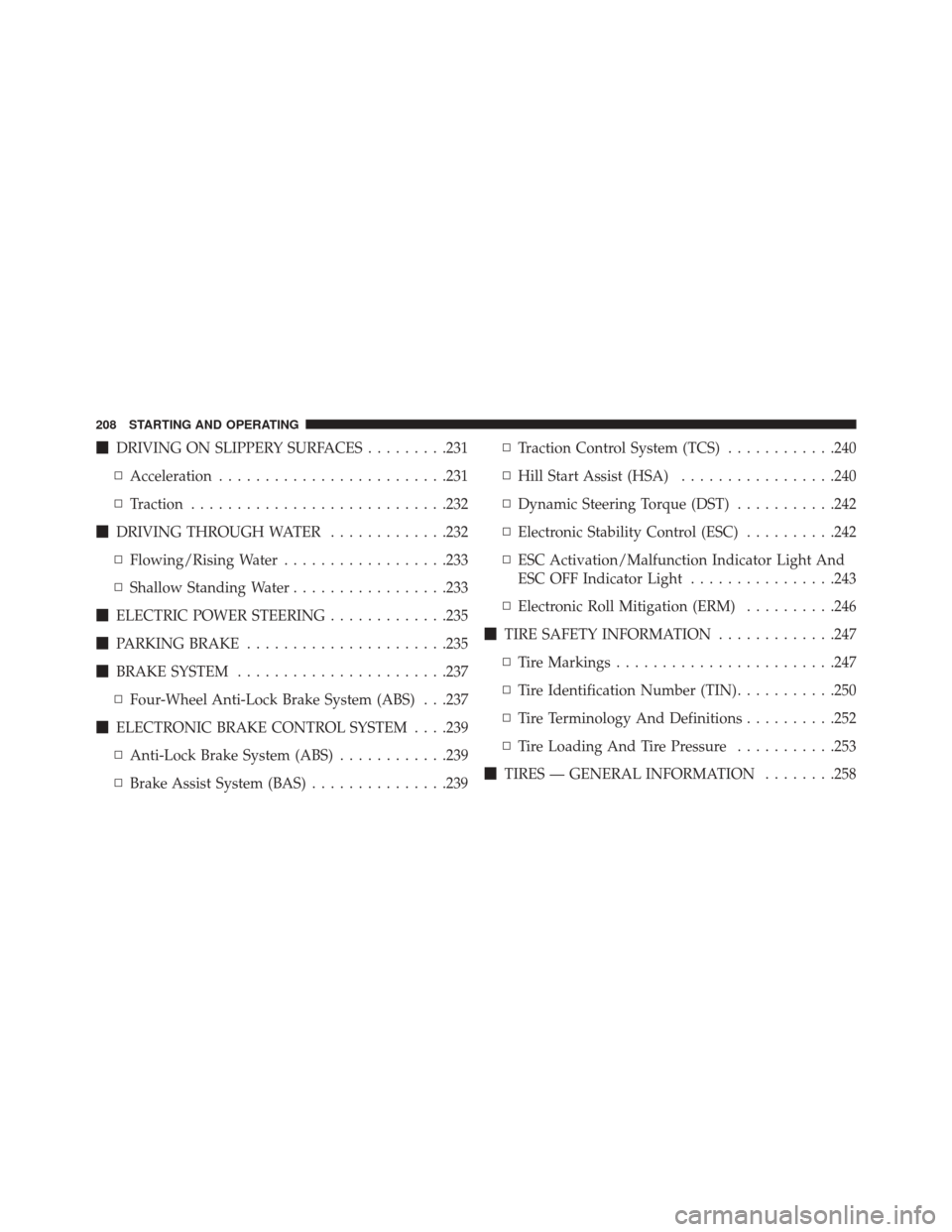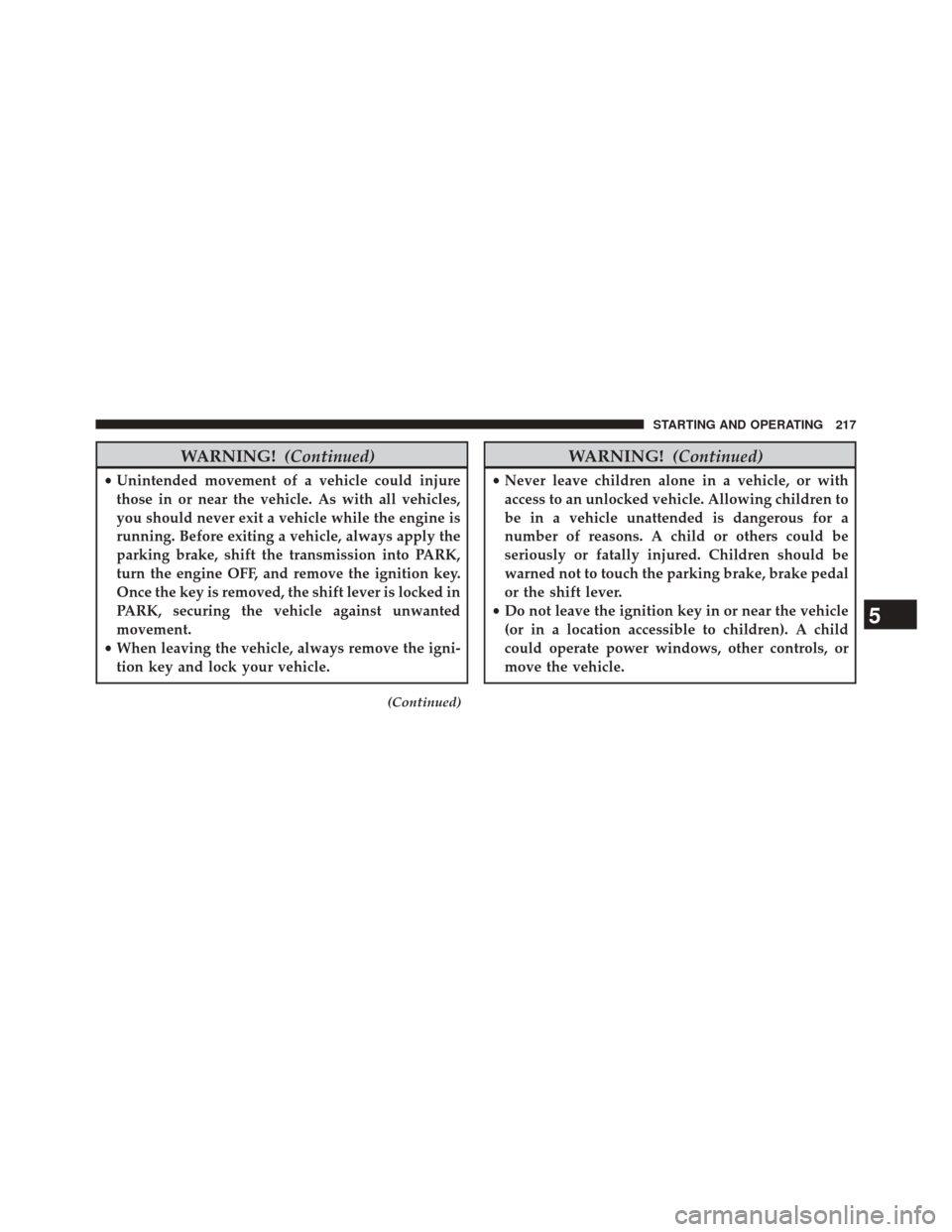Page 200 of 409

Adjusting The Air Temperature
Rotate the Driver Temperature Control, or the Passenger
Temperature Control, dial clockwise or anti clockwise, to
adjust the air temperature in the front left (Driver Tem-
perature Control) or right (Passenger Temperature Con-
trol) zone of the passenger compartment.
The set temperatures are shown on the displays.
Press the SYNC button to align the air temperature
between the two zones.
Turn the Passenger Temperature Control knob to return
to the separate management of air temperatures in the
two zones.
Turning the control knobs completely in one direction or
the other activates the�HI�(maximum heating) or �LO�
(maximum cooling) functions respectively. To deactivate these functions, turn the temperature knob
to the desired temperature.
Air Distribution Selection
By pressing the Mode Control buttons (Up/Down/Right
arrows), it is possible to set one of the seven possible air
distributions manually:
•
Up Arrow – Air flow to the windshield and front side
window diffusers to defrost them. Use Defrost mode
with maximum temperature settings for best wind-
shield and side window defrosting. When the defrost
mode is selected, the blower will automatically default
to medium-high.
• Right Arrow – Air flow at central and side dashboard
vents to ventilate the chest and the face during the hot
season.
198 UNDERSTANDING YOUR INSTRUMENT PANEL
Page 209 of 409
STARTING AND OPERATING
CONTENTS
�STARTING PROCEDURES ................211
▫ Manual Transmission — If Equipped .......211
▫ Automatic Transmission — If Equipped .....211
▫ Normal Starting .......................211
▫ Cold Weather Operation ................212
▫ Extended Park Starting ..................212
▫ If Engine Fails To Start .................213
▫ After Starting ....................... .213
▫ Turbo Charger “Cool Down” .............213�MANUAL TRANSMISSION — IF EQUIPPED . . .214
▫
DOWNSHIFTING .....................215
� AUTOMATIC TRANSMISSION —
IF EQUIPPED ........................ .216
▫ Key Ignition Park Interlock ...............218
▫ Brake/Transmission Shift Interlock System . . .218
▫ Six-Speed Euro Twin Clutch Transmission —
If Equipped ........................ .218
� AUTOSTICK® — IF EQUIPPED ............230
▫ Operation .......................... .230
5
Page 210 of 409

�DRIVING ON SLIPPERY SURFACES .........231
▫ Acceleration ........................ .231
▫ Traction ........................... .232
� DRIVING THROUGH WATER .............232
▫ Flowing/Rising Water ..................233
▫ Shallow Standing Water .................233
� ELECTRIC POWER STEERING .............235
� PARKING BRAKE ..................... .235
� BRAKE SYSTEM ...................... .237
▫ Four-Wheel Anti-Lock Brake System (ABS) . . .237
� ELECTRONIC BRAKE CONTROL SYSTEM . . . .239
▫ Anti-Lock Brake System (ABS) ............239
▫ Brake Assist System (BAS) ...............239 ▫
Traction Control System (TCS) ............240
▫ Hill Start Assist (HSA) .................240
▫ Dynamic Steering Torque (DST) ...........242
▫ Electronic Stability Control (ESC) ..........242
▫ ESC Activation/Malfunction Indicator Light And
ESC OFF Indicator Light ................243
▫ Electronic Roll Mitigation (ERM) ..........246
� TIRE SAFETY INFORMATION .............247
▫ Tire Markings ....................... .247
▫ Tire Identification Number (TIN) ...........250
▫ Tire Terminology And Definitions ..........252
▫ Tire Loading And Tire Pressure ...........253
� TIRES — GENERAL INFORMATION ........258
208 STARTING AND OPERATING
Page 213 of 409

STARTING PROCEDURES
Before starting your vehicle, adjust your seat, adjust both
inside and outside mirrors, and fasten your seat belts.
WARNING!
•Never leave children alone in a vehicle, or with
access to an unlocked vehicle.
• Allowing children to be in a vehicle unattended is
dangerous for a number of reasons. A child or
others could be seriously or fatally injured. Chil-
dren should be warned not to touch the parking
brake, brake pedal or the shift lever.
• Do not leave the Key Fob in or near the vehicle (or
in a location accessible to children). A child could
operate power windows, other controls, or move
the vehicle.
Manual Transmission — If Equipped
Apply the parking brake, place the shift lever in NEU-
TRAL, and press the clutch pedal before starting the
vehicle. This vehicle is equipped with a clutch interlock-
ing ignition system. It will not start unless the clutch
pedal is pressed to the floor.
Automatic Transmission — If Equipped
The shift lever must be in the PARK or NEUTRAL
position before you can start the engine. Depress the
brake pedal before shifting to any driving gear.
NOTE: You must press the brake pedal before shifting
out of PARK.
Normal Starting
NOTE: Normal starting of either a cold or a warm
engine is obtained without pumping or pressing the
accelerator pedal.
5
STARTING AND OPERATING 211
Page 214 of 409

Turn the ignition switch to the AVV/ACC (START)
position and release it when the engine starts. If the
engine fails to start within 10 seconds, turn the ignition
switch to the STOP (OFF/LOCK) position, wait 10 to 15
seconds, then repeat the “Normal Starting” procedure.
Cold Weather Operation
To prevent possible engine damage while starting at low
temperatures, this vehicle will inhibit engine cranking
when the ambient temperature is less than –22° F (–30° C)
and the oil temperature sensor reading indicates an
engine block heater has not been used. An externally-
powered electric engine block heater is available as
optional equipment or from your authorized dealer.
The message “plug in engine heater” will be displayed in
the instrument cluster when the ambient temperature is
below 5° F (–15° C) at the time the engine is shut off as a
reminder to avoid possible crank delays at the next cold
start.NOTE:
Use of the recommended SAE 5W-40 Synthetic oil
and adhering to the prescribed oil change intervals is
important to prevent engine damage and ensure satisfac-
tory starting in cold conditions.
Extended Park Starting
NOTE: Extended Park condition occurs when the vehicle
has not been started or driven for at least 35 days.
1. Install a battery charger or jumper cables to the battery to ensure a full battery charge during the crank cycle.
2. Cycle the ignition in the START position and release it when the engine starts.
3. If the engine fails to start within ten seconds, cycle the ignition to the STOP (OFF/LOCK) position, wait five
seconds to allow the starter to cool, then repeat the
Extended Park Starting procedure.
212 STARTING AND OPERATING
Page 219 of 409

WARNING!(Continued)
•Unintended movement of a vehicle could injure
those in or near the vehicle. As with all vehicles,
you should never exit a vehicle while the engine is
running. Before exiting a vehicle, always apply the
parking brake, shift the transmission into PARK,
turn the engine OFF, and remove the ignition key.
Once the key is removed, the shift lever is locked in
PARK, securing the vehicle against unwanted
movement.
• When leaving the vehicle, always remove the igni-
tion key and lock your vehicle.
(Continued)
WARNING! (Continued)
•Never leave children alone in a vehicle, or with
access to an unlocked vehicle. Allowing children to
be in a vehicle unattended is dangerous for a
number of reasons. A child or others could be
seriously or fatally injured. Children should be
warned not to touch the parking brake, brake pedal
or the shift lever.
• Do not leave the ignition key in or near the vehicle
(or in a location accessible to children). A child
could operate power windows, other controls, or
move the vehicle.
5
STARTING AND OPERATING 217
Page 220 of 409

Key Ignition Park Interlock
This vehicle is equipped with a Key Ignition Park Inter-
lock which requires the transmission to be in PARK
before the ignition switch can be turned to the full OFF
(key removal) position. The key can only be removed
from the ignition when the ignition is in the full OFF
position, and once removed, the transmission is locked in
PARK.
Brake/Transmission Shift Interlock System
This vehicle is equipped with a Brake Transmission Shift
Interlock System (BTSI) that holds the shift lever in PARK
unless the brakes are applied. To shift the transmission
out of PARK, the ignition switch must be turned to the
ON/RUN position (engine running or not), and the
brake pedal (and the lock button on the shift lever) must
be pressed.
Six-Speed Euro Twin Clutch Transmission — If
Equipped
The transmission gear position display (located in the
instrument panel cluster) indicates the transmission gear
range. You must press the brake pedal and the lock
button on the shift lever to move the shift lever out of the
PARK (refer to “Brake/Transmission Shift Interlock Sys-
tem” in this section). To drive, move the shift lever from
PARK or NEUTRAL to the DRIVE position. The
electronically-controlled transmission provides a precise
shift schedule. The transmission electronics are self-
calibrating; therefore, the first few shifts on a new vehicle
may be somewhat abrupt. This is a normal condition, and
precision shifts will develop within a few hundred miles
(kilometers).
218 STARTING AND OPERATING
Page 222 of 409

NOTE:If the shift lever cannot be moved to the PARK,
REVERSE, or NEUTRAL position (when pushed for-
ward) it is probably in the AutoStick (+/-) position
(beside the DRIVE position). In AutoStick mode, the
transmission gear (1, 2, 3, etc.) is displayed in the
instrument cluster. Move the shift lever to the right (into
the DRIVE [D] position) for access to PARK, REVERSE,
and NEUTRAL.
Gear Ranges
DO NOT race the engine when shifting from PARK or
NEUTRAL into another gear range.
NOTE: After selecting any gear range, wait a moment to
allow the selected gear to engage before accelerating.
This is especially important when the engine is cold. PARK (P)
This range supplements the parking brake by locking the
transmission. The engine can be started in this range.
Never attempt to use PARK while the vehicle is in
motion. Apply the parking brake when leaving the
vehicle in this range.
When parking on a level surface, you may shift the
transmission into PARK first, and then apply the parking
brake.
When parking on a hill, apply the parking brake before
shifting the transmission to PARK, otherwise the load on
the transmission locking mechanism may make it diffi-
cult to move the shift lever out of PARK. As an added
precaution, turn the front wheels toward the curb on a
downhill grade and away from the curb on an uphill
grade.
220 STARTING AND OPERATING